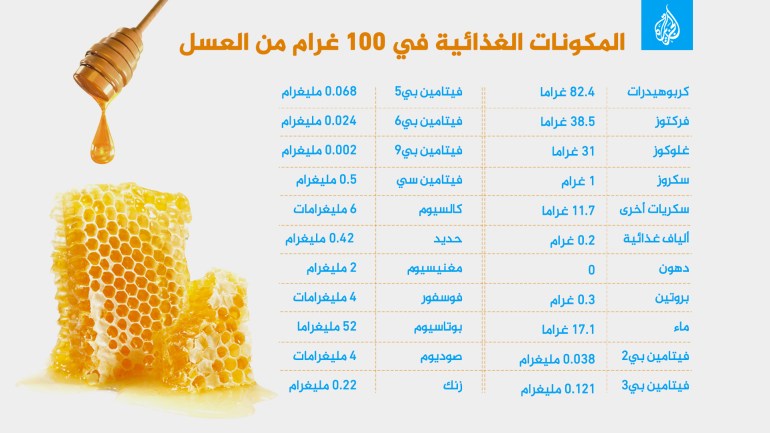What is the difference between honey and sugar in terms of composition, calories and glycemic index?
What is the amount of honey that is allowed to be eaten daily?
What are the advantages of honey?
According to a research paper from the University of Arizona, honey and sugar are both carbs and calorie-dense sweeteners.
What is the difference between honey and sugar in terms of composition?
Honey and sugar are made up of a mixture of glucose and fructose;
In sugar, glucose and fructose bind together to form sucrose, which comes from sugar beets or sugar cane, and is more commonly known as table sugar.
In honey, fructose and glucose are independent of each other. In addition, about 25 types of oligosaccharides - sugars containing between 3 and 10 monosaccharides - were discovered in the composition of honey.
What is the difference between honey and sugar in terms of calories?
One tablespoon of granulated white sugar contains 49 calories, while one tablespoon of honey contains 68 calories, which is the reason for the higher density and weight of honey compared to sugar.
What is the difference between honey and sugar in terms of digestion?
The difference between the digestion of honey and sugar lies in the composition of the enzymes in each of these products.
Sugar (sucrose) passes through the stomach without any digestion taking place due to its disaccharide structure (a sugar made up of two monosaccharides). This means that enzymes in the stomach cannot break down the structure of glucose and fructose in table sugar until it reaches the small intestine. The liver has a few enzymes to convert the molecules into glucose that is able to enter the bloodstream for further use.
Honey differs because of the enzymes that bees add to the nectar, which separate sucrose into two simple sugars;
Fructose and glucose, these sugars are directly absorbed by our bodies and are easier to digest.
What is the difference between honey and sugar in terms of glycemic index?
The glycemic index is a system for classifying foods that contain carbohydrates and shows how quickly each type of food affects the blood sugar level when eaten.
Carbohydrates with a low glycemic index allow only a slight increase in the level of glucose in the blood, while carbohydrates with a high glycemic index lead to an increase in the level of glucose in the blood.
The average glycemic index of honey is 55 ± 5.
In contrast, the average glycemic index for sugar is 68 ± 5.
That is, honey has a lower glycemic index than sugar.
What are the features of honey?
Many of the antioxidants in honey are classified as flavonoids, which have anti-inflammatory properties and may provide some health benefits.
Honey contains, albeit small, amounts of vitamins and minerals.
It may help kill germs because it has antimicrobial properties.
It may also help relieve a cough and sore throat.
What are the downsides to honey?
Honey is rich in calories, and eating it may increase the risk of tooth decay, and it should be treated like sugar, especially for diabetics.
It is not allowed to eat honey for infants under the age of one year, because honey may contain Clostridium botulinum spores that lead to food poisoning.
After the age of one year, the child's digestive system has developed sufficiently, so that it can destroy the spores of bacteria.
As for white sugar, it is relatively lower in calories compared to honey, but it also increases the risk of tooth decay, and your body may find it more difficult to digest sugar than honey, because it does not contain enzymes.
How much honey is allowed to be eaten per day?
According to doctors who participated in a survey conducted by the Russian RIA Novosti news agency, and reported by Russia Today, in order for honey not to negatively affect health, you should not eat more than two tablespoons of it per day.
"It is best to take honey in the first half of the day, accompanied by an active lifestyle," says Head of the Department of Comprehensive Therapy of Sechenov Medical University Professor Alexei Poivirov.
Povirov points out that honey contains antioxidants that prevent cell oxidation, and also contains vitamins and fructose, which is a source of energy.
Experts agree that when choosing a type of honey, it is preferable to buy it in a wax disk, because it guarantees its quality and quality.
How much sugar is allowed to be eaten per day?
The World Health Organization recommends that the intake of free sugars be less than 10% of the total energy intake for a person of a healthy body weight consuming about 2,000 calories per day, which means 50 grams or 12 teaspoons of sugar for an adult.
It is recommended that the intake of free sugars be less than 5% of the total energy intake for additional health benefits, i.e. 6 teaspoons.
Free sugars include white sugar, brown sugar, sugar added to food and beverages by its maker, chef or consumer, and sugars naturally present in honey, syrup, fruit juices and their concentrated compounds.
That is, the sugar in honey is counted among the free sugars, and when eating it must be deducted from the total sugar intake.

